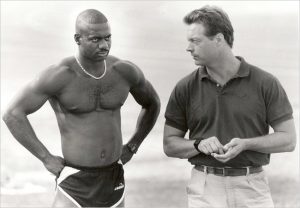What athlete do you look up to? Whose physical qualities (i.e. speed, strength, power) impress you the most? If you enjoy spending time in the gym lifting weights, chances are you’ve already googled your favorite player’s name to see what kind of workouts he or she performs.
The training sessions that are shown online are usually the most grueling ones, meant to challenge even the fittest individuals. Naturally, you end up giving that workout a try because if it’s good for them, it has to be good for you.
The mistake that I see most people make is that they structure their training program around the hardest sessions they have seen or read about online. This leads to a 6-day-per-week, high-intensity program that leaves you lying on the floor, gasping for air after every single session. And while you might think that this is what the pros do day in and day out, the reality is slightly different.
What you see: the tip of the iceberg
It turns out that what is shown online and on TV is only a very small portion of a top athlete’s total training regiment. We love seeing people go through intense workouts, so that’s what is shown to us. Nobody wants to watch a 40-minute video of a professional athlete getting a regenerative massage or watch an elite sprinter performing low-intensity running drills for an entire workout. We want the flashy, the loud and hard-looking stuff because we think that these hard training sessions are what build top-level athletes.

Don’t get me wrong: when these professionals “go hard”, they really give everything that they have. But it’s a big mistake to think that they do these very taxing, high-intensity workouts all the time.
The majority of their week is actually spent performing work that isn’t excessively hard in itself. But it’s this “boring” work that allows them to push as hard as they do in the gym when the time is right. This lower intensity work lays a strong foundation upon which intensity and volume can be built.
Here are a few examples of low-intensity activities that top-level athletes perform more frequently than you might think:
– Mobility/stretching
– Regenerative work (EMS, massage, physio, chiro, etc.)
– Technical/tactical drills
– Tempo runs
– Relaxation/breathing/meditation practice
– Core work
– Light medicine ball circuits
– Weights under 80%
Recovery: the missing piece of the puzzle
You want to work hard in the gym, and that’s a good thing. If you want to get great results, you need to earn them through hard work. What you also need to do is spend some time focusing on your recovery to ensure that this hard work actually ends up being beneficial to you.
“It’s not about how much you train; it’s about how much you can recover from.”
If you only perform hard workouts all the time, your body never gets a chance to regenerate itself and grow. You’re left in a constant state of fatigue that will eventually lead to performance plateaus and leaves you more vulnerable to injuries.
By putting a little bit more effort into your recovery, you will positively affect your progress and make a significant difference on your overall performance. Recovery can take many forms, but the basics are the following:
Nutrition – eat enough protein to maintain/build muscle mass, enough fats to sustain overall health and hormonal balance, enough carbohydrates to support your level of activity, and enough “greens” to guarantee a sufficient intake of vitamins, minerals and phytochemicals.
Sleep – aim for 8+ hours of quality sleep each night. If you want to train like an athlete, you need to sleep like one. Avoid screens before bed, keep room temperature on the cool side, and black out light completely to ensure optimal rest.
Stress – manage your stress levels to avoid any detrimental effect on your performance. Spend quality time with your friends and family, practice relaxation/meditation regularly, and avoid situations and people who have a negative impact on your overall mood, health and well being.

This snippet is from http://www.fatiguescience.com. Click on the link for the full infographic.
Structure of training: a high-low approach
So when do you train hard and when do you take it easy? One of the simplest and most effective ways to structure your training to ensure the best results is to use a “high/low” approach, popularized by the late Charlie Francis.

World-renowned sprint coach Charlie Francis (right) with his athlete Ben Johnson (left)
Credit: Gary Hershorn/Reuters
The premise of this training structure is that anytime you are focusing on maximum speed or explosion, your central nervous system (CNS) is being taxed. Charlie Francis reminds us that “on any given day, there is only so much CNS energy to expend. Whether you access the CNS energy pool via the arms, or the legs, or both, it doesn’t matter, when it’s drained, it’s drained.”(1)
After a true “high-intensity” session, a minimum of 48 hours must be allowed before the next intense training workout can take place.
CNS-taxing activities include:
– Sprinting work
– Heavy resistance training (2-5 rep range)
– Plyometrics (explosive jumping, hopping, skipping, bounding)
– Stair/hill running
– Max effort agility drills and conditioning
– Sparring or heavy bag work
– Explosive throws
Between your days of high-intensity work, you will be focusing on low-intensity activities and regeneration means outlined above. These “easy” workouts won’t tax your nervous system and will allow it to fully recover before the next high-intensity workout.
As a general rule, you should aim for 2 to 3 “high” days per week at the most.
Sample Training Week (3 high days)
Monday (high)
Heavy resistance training (above 80%)
Tuesday (low)
Tempo Runs + light body weight circuit
Wednesday (high)
Hard hill sprints
Thursday (low)
Mobility/stretching
Friday (high)
Heavy resistance training (above 80%)
Saturday (low)
Low-intensity cardio
Sunday (low)
Rest
Auto-regulation of training
The last thing you need to do if you truly want to train like an athlete is to monitor your recovery status consistently. The high/low training structure is an excellent template but it will only give you the best results if you remain flexible and adapt it on the fly, according to your body’s readiness to be taxed at the highest level.
For example, if you’re supposed to do a heavy resistance training session but you haven’t been able to sleep enough and you still feel crushed from the previous hard session, it’s a good idea to adjust the training accordingly.
It’s not easy to listen to your own body and decide if you are ready to push hard or not. We’re led to believe that no matter how you feel, you need to push yourself to the limit every time you train in order to get better. This is not the most sustainable approach to training. In addition to that, if you don’t have a qualified coach who can adjust your training depending on how you look and feel, you need a valid way to do this yourself.

The cheapest and most effective way to monitor your recovery status is to measure your heart rate (HR) when you wake up. Take a week to establish a baseline value while getting lots of sleep every night. Once you’ve done this, use that number as a reference point and compare it to your HR when you wake up. If the morning value is close to your baseline, you’re good to go hard. If you’re 5 beats higher, take it easy. If you’re over 10 beats higher than your baseline, it’s probably a good idea to switch the planned session for a low-intensity workout.
For those of you who are willing to invest into their training, are now widely available. These systems will do the thinking for you and tell you if you are ready to push hard or if you should take a rest day instead.
Conclusion
If you want to train like an athlete, you need to live like one. It’s not enough to work hard inside the gym and on the field; you need to keep working every other minute of the day to ensure great results and reduce your chances of getting injured or over-trained. You also need to organize your training intelligently and not be afraid of the “easy” work. Only then will you be able to express your full potential and see what you’re truly capable of.
References:
(1) Charlie Francis – The Charlie Francis Training System
